Law and Legal System
VerifiedAdded on 2020/12/26
|11
|3351
|204
Homework Assignment
AI Summary
This homework assignment provides a comprehensive analysis of the English legal system, covering various types of laws, key principles of criminal law, the structure of magistrate and crown courts, the appeal process, and the application of legal principles to murder. It is a valuable resource for students seeking to understand the complexities of the English legal system.
Contribute Materials
Your contribution can guide someone’s learning journey. Share your
documents today.
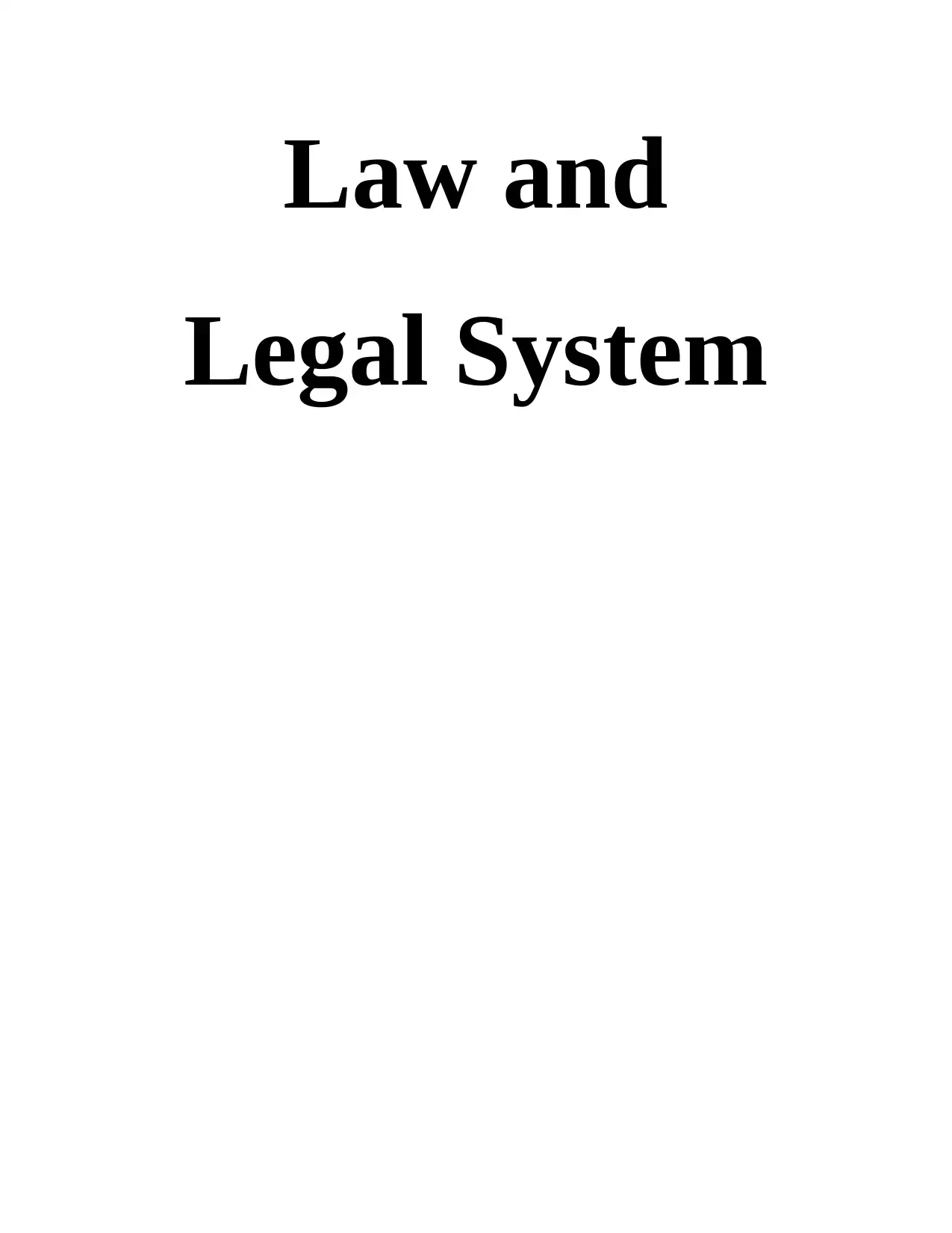
Law and
Legal System
Legal System
Secure Best Marks with AI Grader
Need help grading? Try our AI Grader for instant feedback on your assignments.
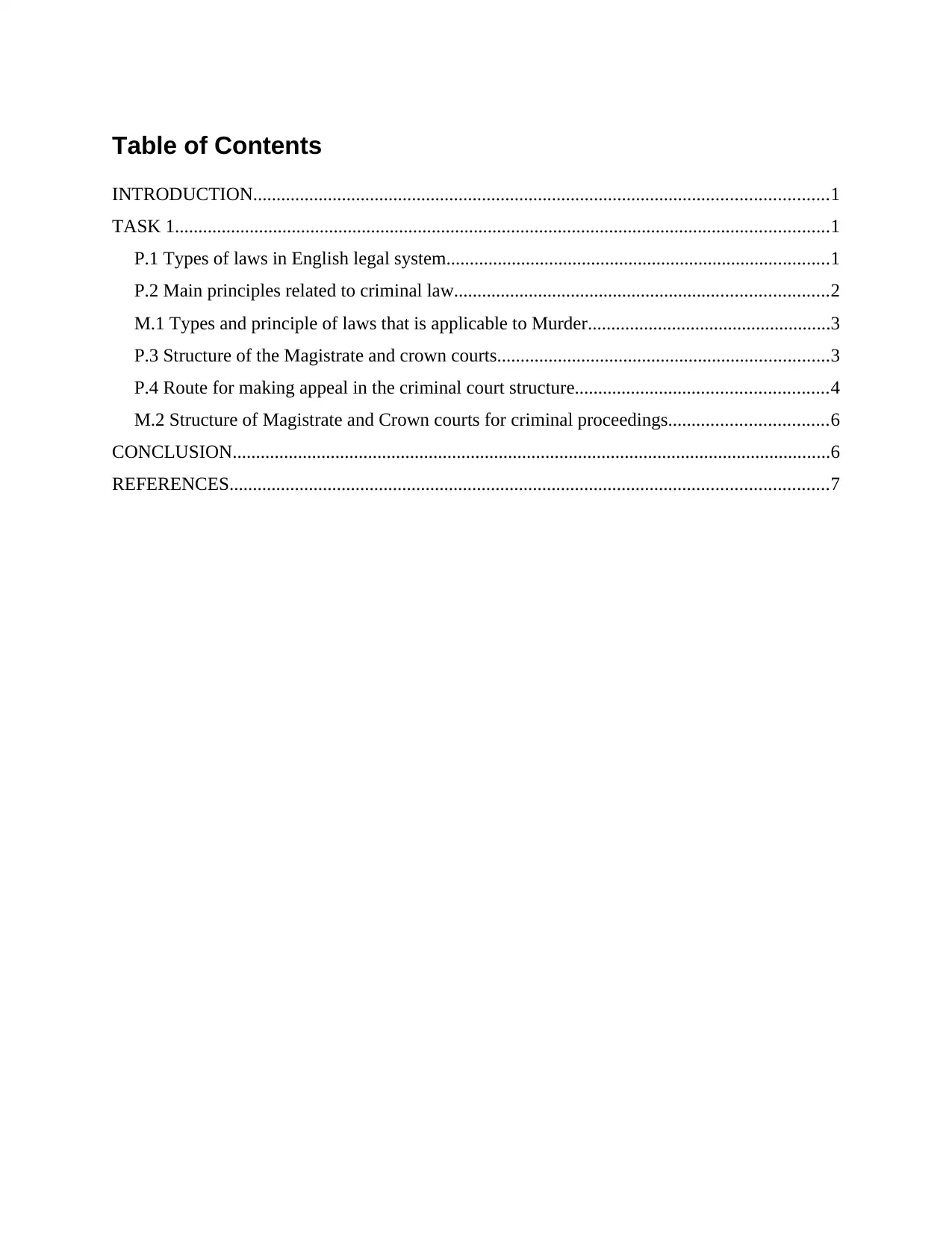
Table of Contents
INTRODUCTION...........................................................................................................................1
TASK 1............................................................................................................................................1
P.1 Types of laws in English legal system..................................................................................1
P.2 Main principles related to criminal law................................................................................2
M.1 Types and principle of laws that is applicable to Murder....................................................3
P.3 Structure of the Magistrate and crown courts.......................................................................3
P.4 Route for making appeal in the criminal court structure......................................................4
M.2 Structure of Magistrate and Crown courts for criminal proceedings..................................6
CONCLUSION................................................................................................................................6
REFERENCES................................................................................................................................7
INTRODUCTION...........................................................................................................................1
TASK 1............................................................................................................................................1
P.1 Types of laws in English legal system..................................................................................1
P.2 Main principles related to criminal law................................................................................2
M.1 Types and principle of laws that is applicable to Murder....................................................3
P.3 Structure of the Magistrate and crown courts.......................................................................3
P.4 Route for making appeal in the criminal court structure......................................................4
M.2 Structure of Magistrate and Crown courts for criminal proceedings..................................6
CONCLUSION................................................................................................................................6
REFERENCES................................................................................................................................7
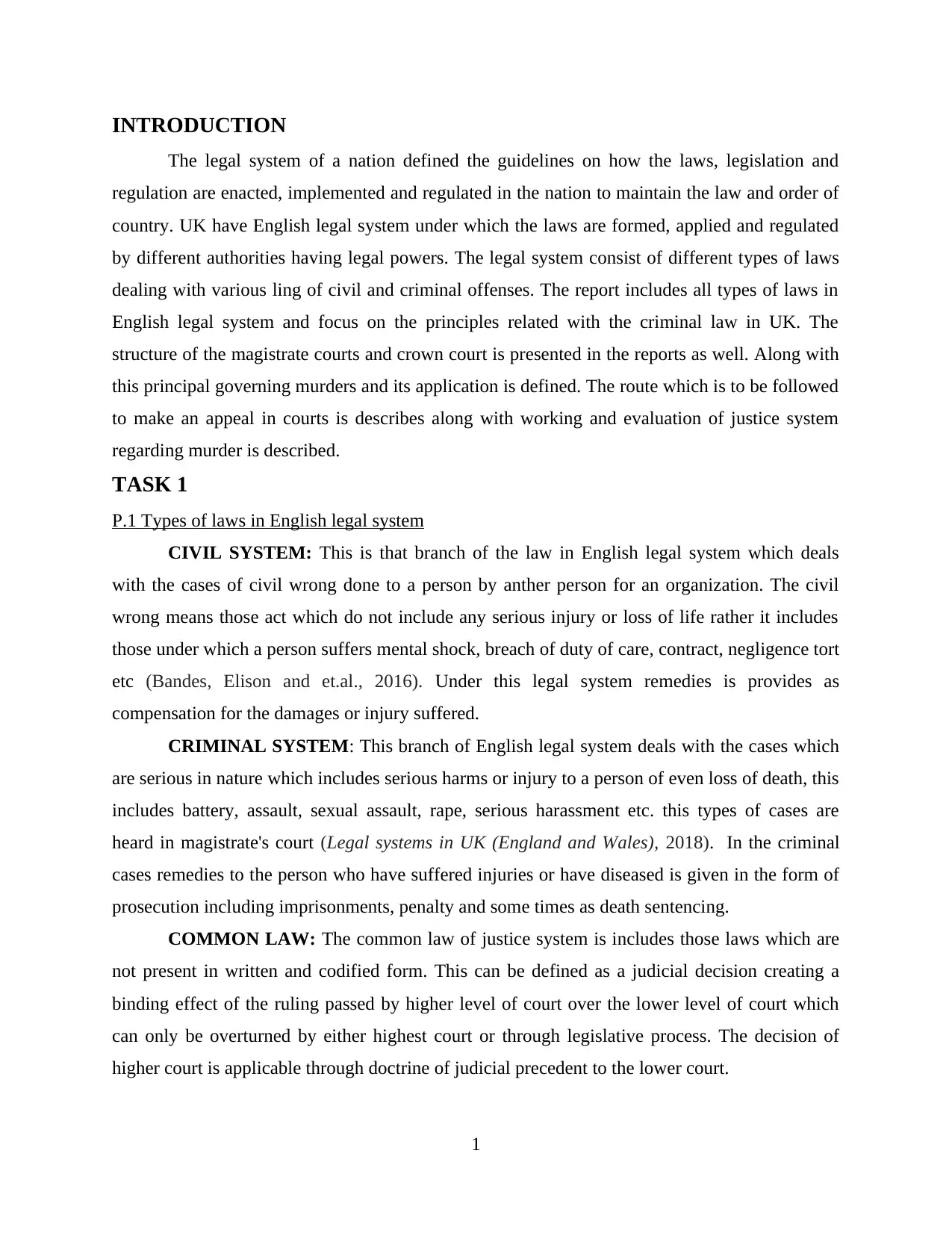
INTRODUCTION
The legal system of a nation defined the guidelines on how the laws, legislation and
regulation are enacted, implemented and regulated in the nation to maintain the law and order of
country. UK have English legal system under which the laws are formed, applied and regulated
by different authorities having legal powers. The legal system consist of different types of laws
dealing with various ling of civil and criminal offenses. The report includes all types of laws in
English legal system and focus on the principles related with the criminal law in UK. The
structure of the magistrate courts and crown court is presented in the reports as well. Along with
this principal governing murders and its application is defined. The route which is to be followed
to make an appeal in courts is describes along with working and evaluation of justice system
regarding murder is described.
TASK 1
P.1 Types of laws in English legal system
CIVIL SYSTEM: This is that branch of the law in English legal system which deals
with the cases of civil wrong done to a person by anther person for an organization. The civil
wrong means those act which do not include any serious injury or loss of life rather it includes
those under which a person suffers mental shock, breach of duty of care, contract, negligence tort
etc (Bandes, Elison and et.al., 2016). Under this legal system remedies is provides as
compensation for the damages or injury suffered.
CRIMINAL SYSTEM: This branch of English legal system deals with the cases which
are serious in nature which includes serious harms or injury to a person of even loss of death, this
includes battery, assault, sexual assault, rape, serious harassment etc. this types of cases are
heard in magistrate's court (Legal systems in UK (England and Wales), 2018). In the criminal
cases remedies to the person who have suffered injuries or have diseased is given in the form of
prosecution including imprisonments, penalty and some times as death sentencing.
COMMON LAW: The common law of justice system is includes those laws which are
not present in written and codified form. This can be defined as a judicial decision creating a
binding effect of the ruling passed by higher level of court over the lower level of court which
can only be overturned by either highest court or through legislative process. The decision of
higher court is applicable through doctrine of judicial precedent to the lower court.
1
The legal system of a nation defined the guidelines on how the laws, legislation and
regulation are enacted, implemented and regulated in the nation to maintain the law and order of
country. UK have English legal system under which the laws are formed, applied and regulated
by different authorities having legal powers. The legal system consist of different types of laws
dealing with various ling of civil and criminal offenses. The report includes all types of laws in
English legal system and focus on the principles related with the criminal law in UK. The
structure of the magistrate courts and crown court is presented in the reports as well. Along with
this principal governing murders and its application is defined. The route which is to be followed
to make an appeal in courts is describes along with working and evaluation of justice system
regarding murder is described.
TASK 1
P.1 Types of laws in English legal system
CIVIL SYSTEM: This is that branch of the law in English legal system which deals
with the cases of civil wrong done to a person by anther person for an organization. The civil
wrong means those act which do not include any serious injury or loss of life rather it includes
those under which a person suffers mental shock, breach of duty of care, contract, negligence tort
etc (Bandes, Elison and et.al., 2016). Under this legal system remedies is provides as
compensation for the damages or injury suffered.
CRIMINAL SYSTEM: This branch of English legal system deals with the cases which
are serious in nature which includes serious harms or injury to a person of even loss of death, this
includes battery, assault, sexual assault, rape, serious harassment etc. this types of cases are
heard in magistrate's court (Legal systems in UK (England and Wales), 2018). In the criminal
cases remedies to the person who have suffered injuries or have diseased is given in the form of
prosecution including imprisonments, penalty and some times as death sentencing.
COMMON LAW: The common law of justice system is includes those laws which are
not present in written and codified form. This can be defined as a judicial decision creating a
binding effect of the ruling passed by higher level of court over the lower level of court which
can only be overturned by either highest court or through legislative process. The decision of
higher court is applicable through doctrine of judicial precedent to the lower court.
1
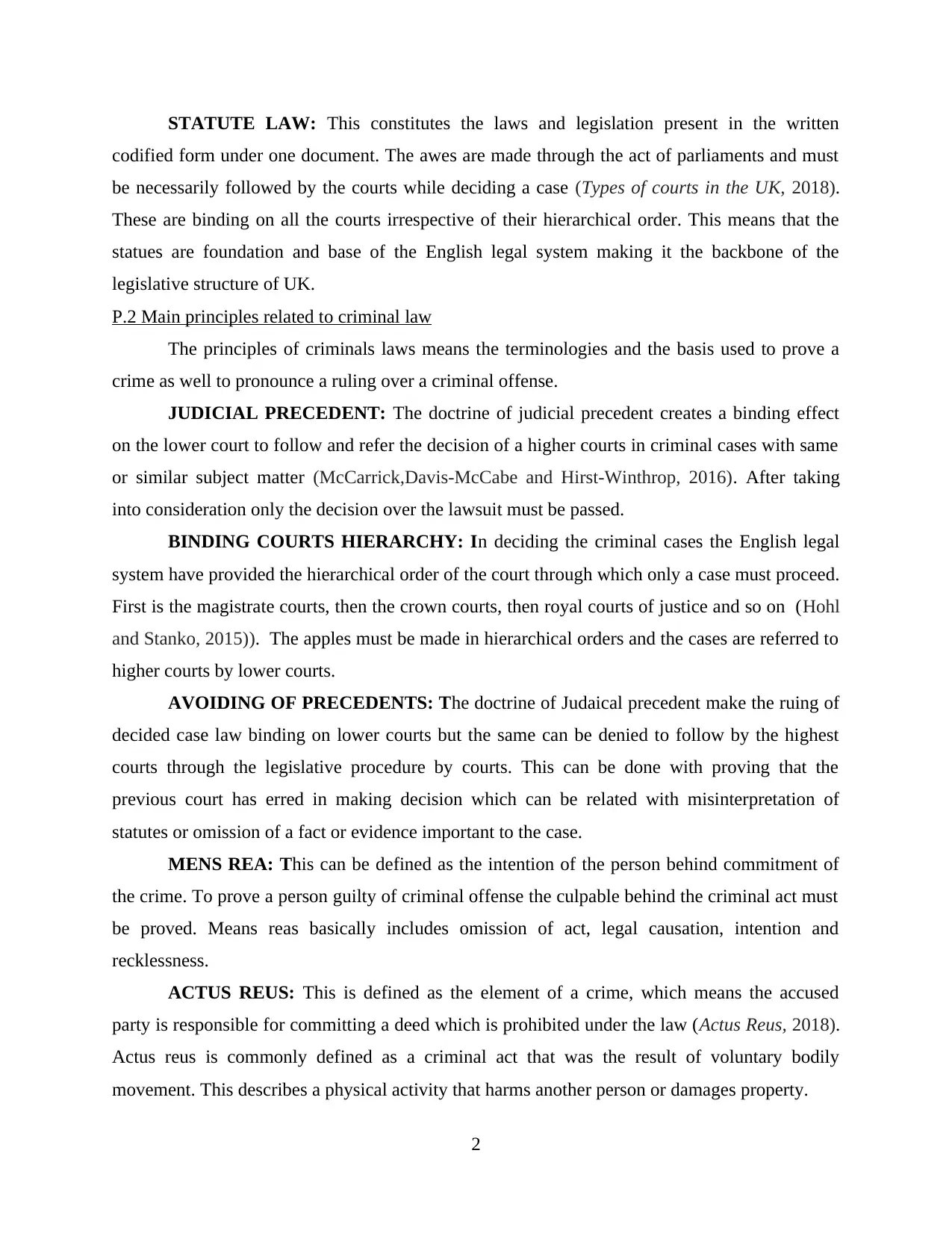
STATUTE LAW: This constitutes the laws and legislation present in the written
codified form under one document. The awes are made through the act of parliaments and must
be necessarily followed by the courts while deciding a case (Types of courts in the UK, 2018).
These are binding on all the courts irrespective of their hierarchical order. This means that the
statues are foundation and base of the English legal system making it the backbone of the
legislative structure of UK.
P.2 Main principles related to criminal law
The principles of criminals laws means the terminologies and the basis used to prove a
crime as well to pronounce a ruling over a criminal offense.
JUDICIAL PRECEDENT: The doctrine of judicial precedent creates a binding effect
on the lower court to follow and refer the decision of a higher courts in criminal cases with same
or similar subject matter (McCarrick,Davis-McCabe and Hirst-Winthrop, 2016). After taking
into consideration only the decision over the lawsuit must be passed.
BINDING COURTS HIERARCHY: In deciding the criminal cases the English legal
system have provided the hierarchical order of the court through which only a case must proceed.
First is the magistrate courts, then the crown courts, then royal courts of justice and so on (Hohl
and Stanko, 2015)). The apples must be made in hierarchical orders and the cases are referred to
higher courts by lower courts.
AVOIDING OF PRECEDENTS: The doctrine of Judaical precedent make the ruing of
decided case law binding on lower courts but the same can be denied to follow by the highest
courts through the legislative procedure by courts. This can be done with proving that the
previous court has erred in making decision which can be related with misinterpretation of
statutes or omission of a fact or evidence important to the case.
MENS REA: This can be defined as the intention of the person behind commitment of
the crime. To prove a person guilty of criminal offense the culpable behind the criminal act must
be proved. Means reas basically includes omission of act, legal causation, intention and
recklessness.
ACTUS REUS: This is defined as the element of a crime, which means the accused
party is responsible for committing a deed which is prohibited under the law (Actus Reus, 2018).
Actus reus is commonly defined as a criminal act that was the result of voluntary bodily
movement. This describes a physical activity that harms another person or damages property.
2
codified form under one document. The awes are made through the act of parliaments and must
be necessarily followed by the courts while deciding a case (Types of courts in the UK, 2018).
These are binding on all the courts irrespective of their hierarchical order. This means that the
statues are foundation and base of the English legal system making it the backbone of the
legislative structure of UK.
P.2 Main principles related to criminal law
The principles of criminals laws means the terminologies and the basis used to prove a
crime as well to pronounce a ruling over a criminal offense.
JUDICIAL PRECEDENT: The doctrine of judicial precedent creates a binding effect
on the lower court to follow and refer the decision of a higher courts in criminal cases with same
or similar subject matter (McCarrick,Davis-McCabe and Hirst-Winthrop, 2016). After taking
into consideration only the decision over the lawsuit must be passed.
BINDING COURTS HIERARCHY: In deciding the criminal cases the English legal
system have provided the hierarchical order of the court through which only a case must proceed.
First is the magistrate courts, then the crown courts, then royal courts of justice and so on (Hohl
and Stanko, 2015)). The apples must be made in hierarchical orders and the cases are referred to
higher courts by lower courts.
AVOIDING OF PRECEDENTS: The doctrine of Judaical precedent make the ruing of
decided case law binding on lower courts but the same can be denied to follow by the highest
courts through the legislative procedure by courts. This can be done with proving that the
previous court has erred in making decision which can be related with misinterpretation of
statutes or omission of a fact or evidence important to the case.
MENS REA: This can be defined as the intention of the person behind commitment of
the crime. To prove a person guilty of criminal offense the culpable behind the criminal act must
be proved. Means reas basically includes omission of act, legal causation, intention and
recklessness.
ACTUS REUS: This is defined as the element of a crime, which means the accused
party is responsible for committing a deed which is prohibited under the law (Actus Reus, 2018).
Actus reus is commonly defined as a criminal act that was the result of voluntary bodily
movement. This describes a physical activity that harms another person or damages property.
2
Secure Best Marks with AI Grader
Need help grading? Try our AI Grader for instant feedback on your assignments.
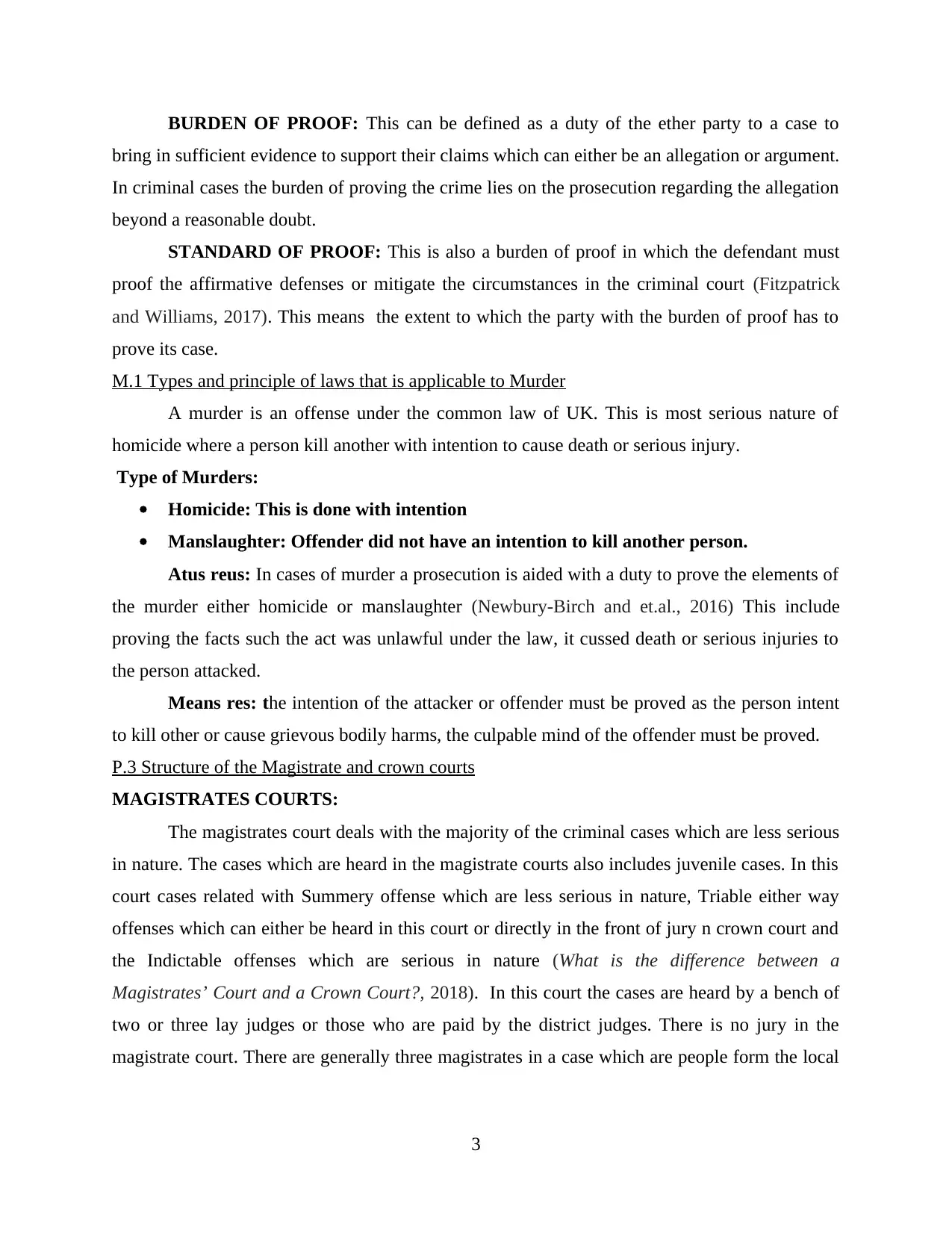
BURDEN OF PROOF: This can be defined as a duty of the ether party to a case to
bring in sufficient evidence to support their claims which can either be an allegation or argument.
In criminal cases the burden of proving the crime lies on the prosecution regarding the allegation
beyond a reasonable doubt.
STANDARD OF PROOF: This is also a burden of proof in which the defendant must
proof the affirmative defenses or mitigate the circumstances in the criminal court (Fitzpatrick
and Williams, 2017). This means the extent to which the party with the burden of proof has to
prove its case.
M.1 Types and principle of laws that is applicable to Murder
A murder is an offense under the common law of UK. This is most serious nature of
homicide where a person kill another with intention to cause death or serious injury.
Type of Murders:
Homicide: This is done with intention
Manslaughter: Offender did not have an intention to kill another person.
Atus reus: In cases of murder a prosecution is aided with a duty to prove the elements of
the murder either homicide or manslaughter (Newbury-Birch and et.al., 2016) This include
proving the facts such the act was unlawful under the law, it cussed death or serious injuries to
the person attacked.
Means res: the intention of the attacker or offender must be proved as the person intent
to kill other or cause grievous bodily harms, the culpable mind of the offender must be proved.
P.3 Structure of the Magistrate and crown courts
MAGISTRATES COURTS:
The magistrates court deals with the majority of the criminal cases which are less serious
in nature. The cases which are heard in the magistrate courts also includes juvenile cases. In this
court cases related with Summery offense which are less serious in nature, Triable either way
offenses which can either be heard in this court or directly in the front of jury n crown court and
the Indictable offenses which are serious in nature (What is the difference between a
Magistrates’ Court and a Crown Court?, 2018). In this court the cases are heard by a bench of
two or three lay judges or those who are paid by the district judges. There is no jury in the
magistrate court. There are generally three magistrates in a case which are people form the local
3
bring in sufficient evidence to support their claims which can either be an allegation or argument.
In criminal cases the burden of proving the crime lies on the prosecution regarding the allegation
beyond a reasonable doubt.
STANDARD OF PROOF: This is also a burden of proof in which the defendant must
proof the affirmative defenses or mitigate the circumstances in the criminal court (Fitzpatrick
and Williams, 2017). This means the extent to which the party with the burden of proof has to
prove its case.
M.1 Types and principle of laws that is applicable to Murder
A murder is an offense under the common law of UK. This is most serious nature of
homicide where a person kill another with intention to cause death or serious injury.
Type of Murders:
Homicide: This is done with intention
Manslaughter: Offender did not have an intention to kill another person.
Atus reus: In cases of murder a prosecution is aided with a duty to prove the elements of
the murder either homicide or manslaughter (Newbury-Birch and et.al., 2016) This include
proving the facts such the act was unlawful under the law, it cussed death or serious injuries to
the person attacked.
Means res: the intention of the attacker or offender must be proved as the person intent
to kill other or cause grievous bodily harms, the culpable mind of the offender must be proved.
P.3 Structure of the Magistrate and crown courts
MAGISTRATES COURTS:
The magistrates court deals with the majority of the criminal cases which are less serious
in nature. The cases which are heard in the magistrate courts also includes juvenile cases. In this
court cases related with Summery offense which are less serious in nature, Triable either way
offenses which can either be heard in this court or directly in the front of jury n crown court and
the Indictable offenses which are serious in nature (What is the difference between a
Magistrates’ Court and a Crown Court?, 2018). In this court the cases are heard by a bench of
two or three lay judges or those who are paid by the district judges. There is no jury in the
magistrate court. There are generally three magistrates in a case which are people form the local
3
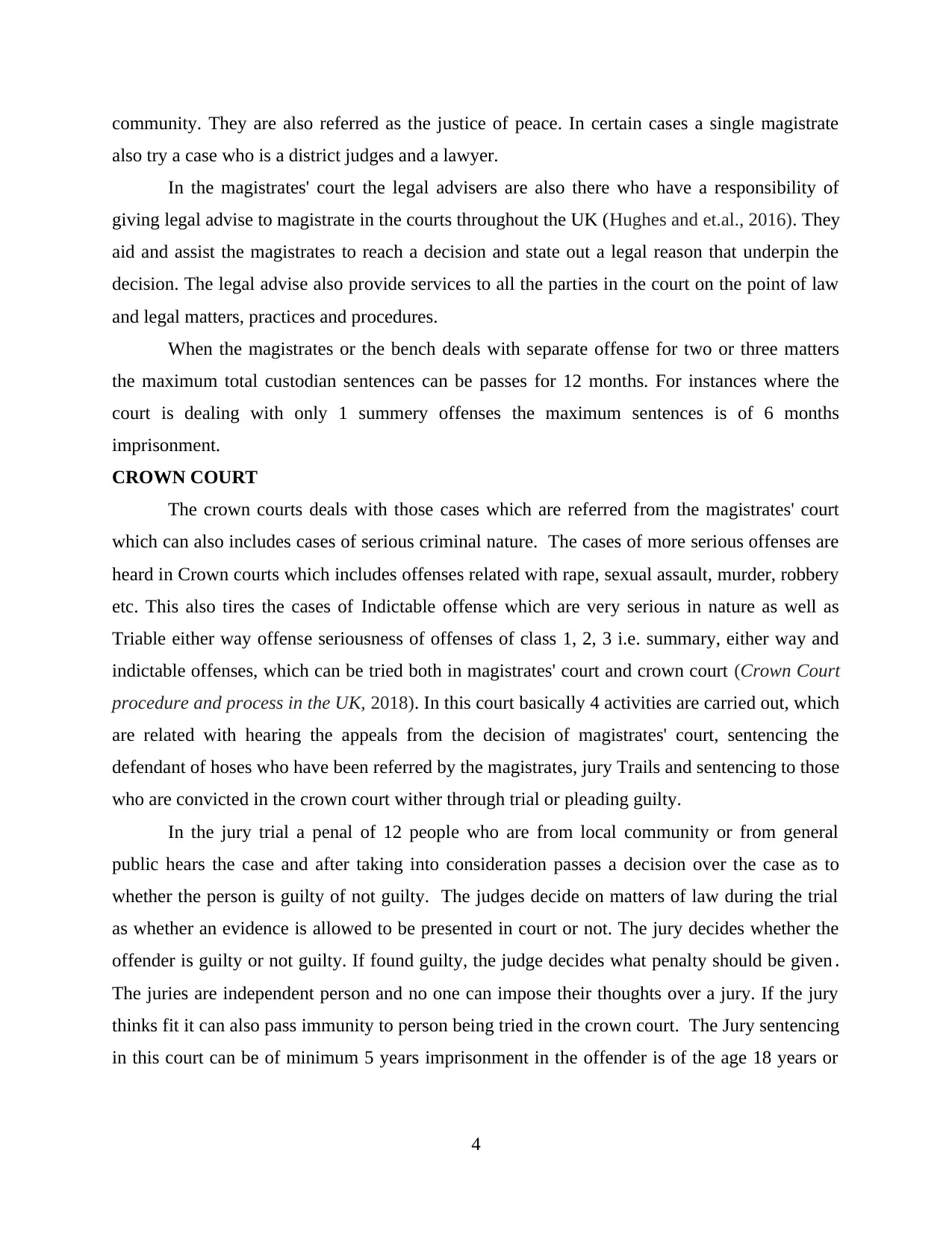
community. They are also referred as the justice of peace. In certain cases a single magistrate
also try a case who is a district judges and a lawyer.
In the magistrates' court the legal advisers are also there who have a responsibility of
giving legal advise to magistrate in the courts throughout the UK (Hughes and et.al., 2016). They
aid and assist the magistrates to reach a decision and state out a legal reason that underpin the
decision. The legal advise also provide services to all the parties in the court on the point of law
and legal matters, practices and procedures.
When the magistrates or the bench deals with separate offense for two or three matters
the maximum total custodian sentences can be passes for 12 months. For instances where the
court is dealing with only 1 summery offenses the maximum sentences is of 6 months
imprisonment.
CROWN COURT
The crown courts deals with those cases which are referred from the magistrates' court
which can also includes cases of serious criminal nature. The cases of more serious offenses are
heard in Crown courts which includes offenses related with rape, sexual assault, murder, robbery
etc. This also tires the cases of Indictable offense which are very serious in nature as well as
Triable either way offense seriousness of offenses of class 1, 2, 3 i.e. summary, either way and
indictable offenses, which can be tried both in magistrates' court and crown court (Crown Court
procedure and process in the UK, 2018). In this court basically 4 activities are carried out, which
are related with hearing the appeals from the decision of magistrates' court, sentencing the
defendant of hoses who have been referred by the magistrates, jury Trails and sentencing to those
who are convicted in the crown court wither through trial or pleading guilty.
In the jury trial a penal of 12 people who are from local community or from general
public hears the case and after taking into consideration passes a decision over the case as to
whether the person is guilty of not guilty. The judges decide on matters of law during the trial
as whether an evidence is allowed to be presented in court or not. The jury decides whether the
offender is guilty or not guilty. If found guilty, the judge decides what penalty should be given.
The juries are independent person and no one can impose their thoughts over a jury. If the jury
thinks fit it can also pass immunity to person being tried in the crown court. The Jury sentencing
in this court can be of minimum 5 years imprisonment in the offender is of the age 18 years or
4
also try a case who is a district judges and a lawyer.
In the magistrates' court the legal advisers are also there who have a responsibility of
giving legal advise to magistrate in the courts throughout the UK (Hughes and et.al., 2016). They
aid and assist the magistrates to reach a decision and state out a legal reason that underpin the
decision. The legal advise also provide services to all the parties in the court on the point of law
and legal matters, practices and procedures.
When the magistrates or the bench deals with separate offense for two or three matters
the maximum total custodian sentences can be passes for 12 months. For instances where the
court is dealing with only 1 summery offenses the maximum sentences is of 6 months
imprisonment.
CROWN COURT
The crown courts deals with those cases which are referred from the magistrates' court
which can also includes cases of serious criminal nature. The cases of more serious offenses are
heard in Crown courts which includes offenses related with rape, sexual assault, murder, robbery
etc. This also tires the cases of Indictable offense which are very serious in nature as well as
Triable either way offense seriousness of offenses of class 1, 2, 3 i.e. summary, either way and
indictable offenses, which can be tried both in magistrates' court and crown court (Crown Court
procedure and process in the UK, 2018). In this court basically 4 activities are carried out, which
are related with hearing the appeals from the decision of magistrates' court, sentencing the
defendant of hoses who have been referred by the magistrates, jury Trails and sentencing to those
who are convicted in the crown court wither through trial or pleading guilty.
In the jury trial a penal of 12 people who are from local community or from general
public hears the case and after taking into consideration passes a decision over the case as to
whether the person is guilty of not guilty. The judges decide on matters of law during the trial
as whether an evidence is allowed to be presented in court or not. The jury decides whether the
offender is guilty or not guilty. If found guilty, the judge decides what penalty should be given.
The juries are independent person and no one can impose their thoughts over a jury. If the jury
thinks fit it can also pass immunity to person being tried in the crown court. The Jury sentencing
in this court can be of minimum 5 years imprisonment in the offender is of the age 18 years or
4
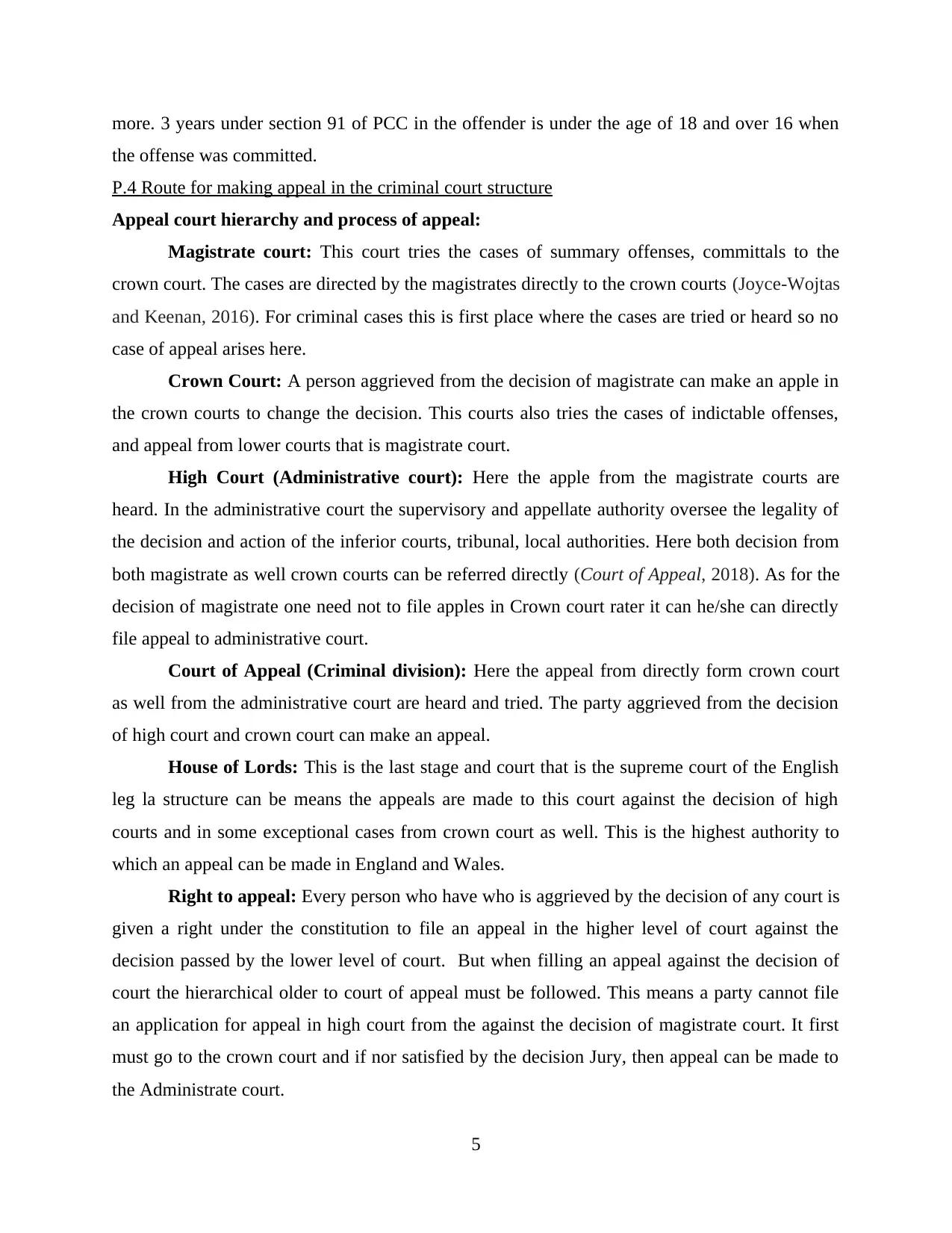
more. 3 years under section 91 of PCC in the offender is under the age of 18 and over 16 when
the offense was committed.
P.4 Route for making appeal in the criminal court structure
Appeal court hierarchy and process of appeal:
Magistrate court: This court tries the cases of summary offenses, committals to the
crown court. The cases are directed by the magistrates directly to the crown courts (Joyce-Wojtas
and Keenan, 2016). For criminal cases this is first place where the cases are tried or heard so no
case of appeal arises here.
Crown Court: A person aggrieved from the decision of magistrate can make an apple in
the crown courts to change the decision. This courts also tries the cases of indictable offenses,
and appeal from lower courts that is magistrate court.
High Court (Administrative court): Here the apple from the magistrate courts are
heard. In the administrative court the supervisory and appellate authority oversee the legality of
the decision and action of the inferior courts, tribunal, local authorities. Here both decision from
both magistrate as well crown courts can be referred directly (Court of Appeal, 2018). As for the
decision of magistrate one need not to file apples in Crown court rater it can he/she can directly
file appeal to administrative court.
Court of Appeal (Criminal division): Here the appeal from directly form crown court
as well from the administrative court are heard and tried. The party aggrieved from the decision
of high court and crown court can make an appeal.
House of Lords: This is the last stage and court that is the supreme court of the English
leg la structure can be means the appeals are made to this court against the decision of high
courts and in some exceptional cases from crown court as well. This is the highest authority to
which an appeal can be made in England and Wales.
Right to appeal: Every person who have who is aggrieved by the decision of any court is
given a right under the constitution to file an appeal in the higher level of court against the
decision passed by the lower level of court. But when filling an appeal against the decision of
court the hierarchical older to court of appeal must be followed. This means a party cannot file
an application for appeal in high court from the against the decision of magistrate court. It first
must go to the crown court and if nor satisfied by the decision Jury, then appeal can be made to
the Administrate court.
5
the offense was committed.
P.4 Route for making appeal in the criminal court structure
Appeal court hierarchy and process of appeal:
Magistrate court: This court tries the cases of summary offenses, committals to the
crown court. The cases are directed by the magistrates directly to the crown courts (Joyce-Wojtas
and Keenan, 2016). For criminal cases this is first place where the cases are tried or heard so no
case of appeal arises here.
Crown Court: A person aggrieved from the decision of magistrate can make an apple in
the crown courts to change the decision. This courts also tries the cases of indictable offenses,
and appeal from lower courts that is magistrate court.
High Court (Administrative court): Here the apple from the magistrate courts are
heard. In the administrative court the supervisory and appellate authority oversee the legality of
the decision and action of the inferior courts, tribunal, local authorities. Here both decision from
both magistrate as well crown courts can be referred directly (Court of Appeal, 2018). As for the
decision of magistrate one need not to file apples in Crown court rater it can he/she can directly
file appeal to administrative court.
Court of Appeal (Criminal division): Here the appeal from directly form crown court
as well from the administrative court are heard and tried. The party aggrieved from the decision
of high court and crown court can make an appeal.
House of Lords: This is the last stage and court that is the supreme court of the English
leg la structure can be means the appeals are made to this court against the decision of high
courts and in some exceptional cases from crown court as well. This is the highest authority to
which an appeal can be made in England and Wales.
Right to appeal: Every person who have who is aggrieved by the decision of any court is
given a right under the constitution to file an appeal in the higher level of court against the
decision passed by the lower level of court. But when filling an appeal against the decision of
court the hierarchical older to court of appeal must be followed. This means a party cannot file
an application for appeal in high court from the against the decision of magistrate court. It first
must go to the crown court and if nor satisfied by the decision Jury, then appeal can be made to
the Administrate court.
5
Paraphrase This Document
Need a fresh take? Get an instant paraphrase of this document with our AI Paraphraser
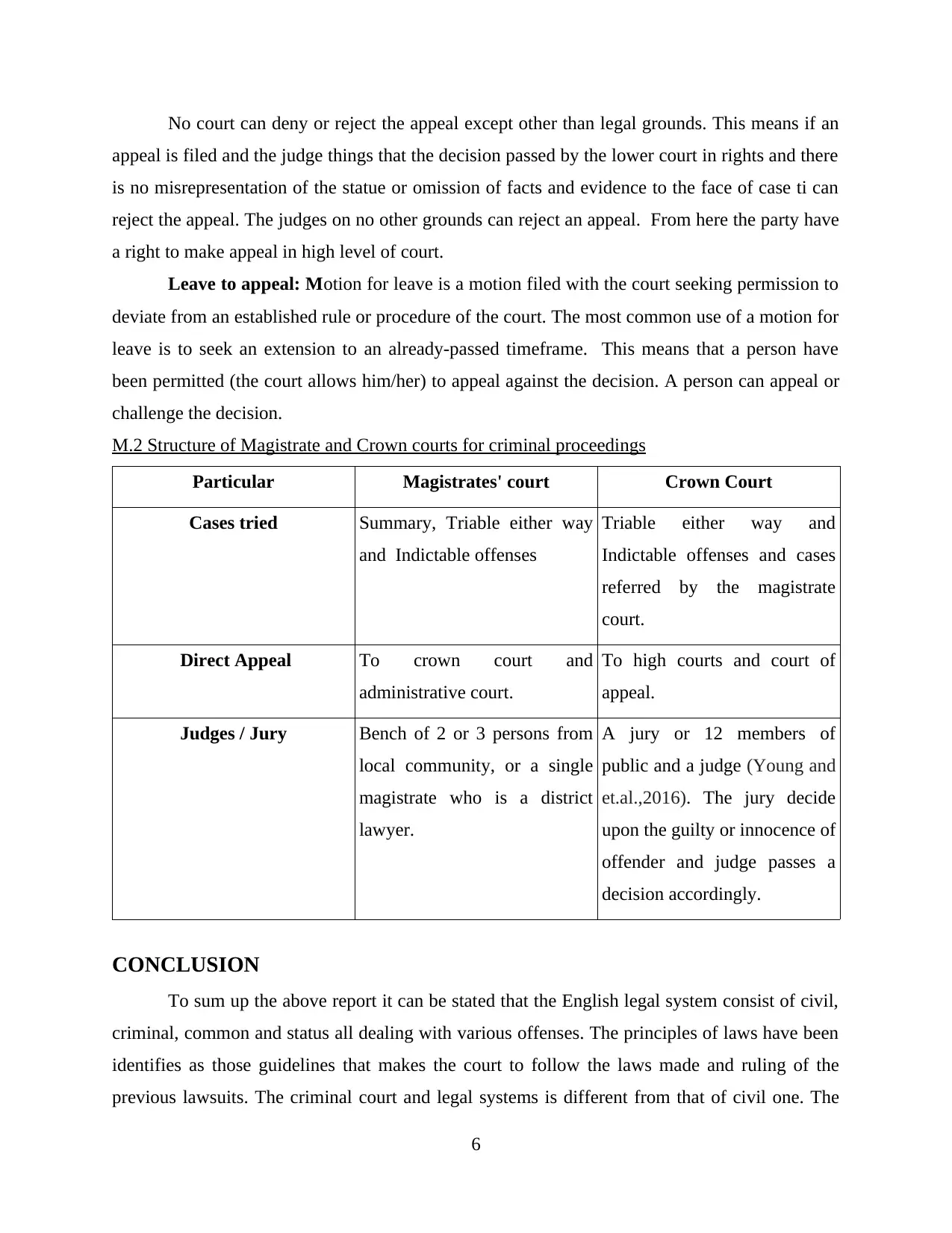
No court can deny or reject the appeal except other than legal grounds. This means if an
appeal is filed and the judge things that the decision passed by the lower court in rights and there
is no misrepresentation of the statue or omission of facts and evidence to the face of case ti can
reject the appeal. The judges on no other grounds can reject an appeal. From here the party have
a right to make appeal in high level of court.
Leave to appeal: Motion for leave is a motion filed with the court seeking permission to
deviate from an established rule or procedure of the court. The most common use of a motion for
leave is to seek an extension to an already-passed timeframe. This means that a person have
been permitted (the court allows him/her) to appeal against the decision. A person can appeal or
challenge the decision.
M.2 Structure of Magistrate and Crown courts for criminal proceedings
Particular Magistrates' court Crown Court
Cases tried Summary, Triable either way
and Indictable offenses
Triable either way and
Indictable offenses and cases
referred by the magistrate
court.
Direct Appeal To crown court and
administrative court.
To high courts and court of
appeal.
Judges / Jury Bench of 2 or 3 persons from
local community, or a single
magistrate who is a district
lawyer.
A jury or 12 members of
public and a judge (Young and
et.al.,2016). The jury decide
upon the guilty or innocence of
offender and judge passes a
decision accordingly.
CONCLUSION
To sum up the above report it can be stated that the English legal system consist of civil,
criminal, common and status all dealing with various offenses. The principles of laws have been
identifies as those guidelines that makes the court to follow the laws made and ruling of the
previous lawsuits. The criminal court and legal systems is different from that of civil one. The
6
appeal is filed and the judge things that the decision passed by the lower court in rights and there
is no misrepresentation of the statue or omission of facts and evidence to the face of case ti can
reject the appeal. The judges on no other grounds can reject an appeal. From here the party have
a right to make appeal in high level of court.
Leave to appeal: Motion for leave is a motion filed with the court seeking permission to
deviate from an established rule or procedure of the court. The most common use of a motion for
leave is to seek an extension to an already-passed timeframe. This means that a person have
been permitted (the court allows him/her) to appeal against the decision. A person can appeal or
challenge the decision.
M.2 Structure of Magistrate and Crown courts for criminal proceedings
Particular Magistrates' court Crown Court
Cases tried Summary, Triable either way
and Indictable offenses
Triable either way and
Indictable offenses and cases
referred by the magistrate
court.
Direct Appeal To crown court and
administrative court.
To high courts and court of
appeal.
Judges / Jury Bench of 2 or 3 persons from
local community, or a single
magistrate who is a district
lawyer.
A jury or 12 members of
public and a judge (Young and
et.al.,2016). The jury decide
upon the guilty or innocence of
offender and judge passes a
decision accordingly.
CONCLUSION
To sum up the above report it can be stated that the English legal system consist of civil,
criminal, common and status all dealing with various offenses. The principles of laws have been
identifies as those guidelines that makes the court to follow the laws made and ruling of the
previous lawsuits. The criminal court and legal systems is different from that of civil one. The
6

proceeding in the magistrate courts are different from that of crown court. In the former one the
summery offense are tried and hearts and for the same sentencing is pronounced. Instead, in the
crown court indictable of fences are heard for it jury decided upon the ruing of case. Moreover,
while making the criminal appeal court structure provides the hierarchic of court as it against the
decision of which court t appeal can be made and that too in which court.
7
summery offense are tried and hearts and for the same sentencing is pronounced. Instead, in the
crown court indictable of fences are heard for it jury decided upon the ruing of case. Moreover,
while making the criminal appeal court structure provides the hierarchic of court as it against the
decision of which court t appeal can be made and that too in which court.
7
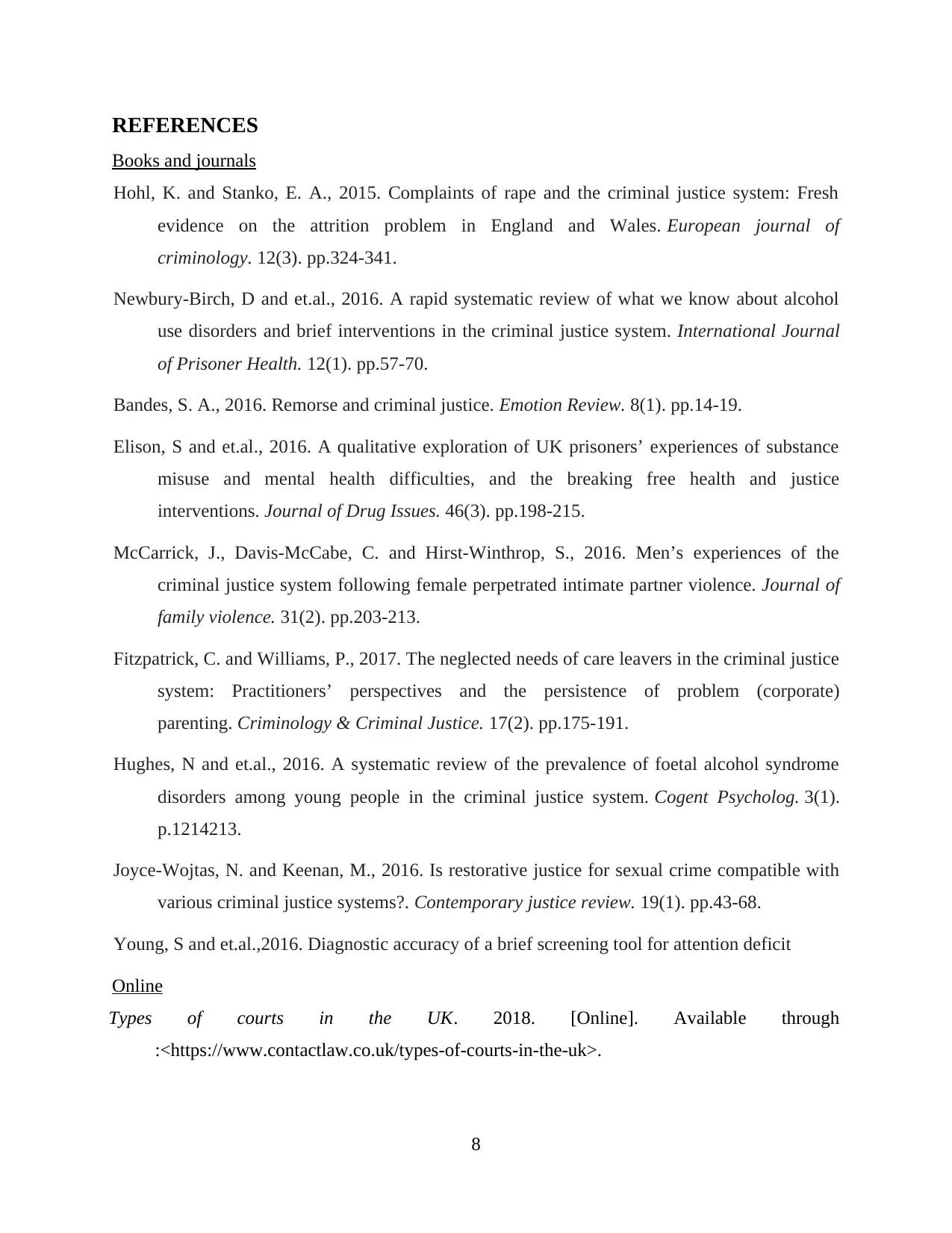
REFERENCES
Books and journals
Hohl, K. and Stanko, E. A., 2015. Complaints of rape and the criminal justice system: Fresh
evidence on the attrition problem in England and Wales. European journal of
criminology. 12(3). pp.324-341.
Newbury-Birch, D and et.al., 2016. A rapid systematic review of what we know about alcohol
use disorders and brief interventions in the criminal justice system. International Journal
of Prisoner Health. 12(1). pp.57-70.
Bandes, S. A., 2016. Remorse and criminal justice. Emotion Review. 8(1). pp.14-19.
Elison, S and et.al., 2016. A qualitative exploration of UK prisoners’ experiences of substance
misuse and mental health difficulties, and the breaking free health and justice
interventions. Journal of Drug Issues. 46(3). pp.198-215.
McCarrick, J., Davis-McCabe, C. and Hirst-Winthrop, S., 2016. Men’s experiences of the
criminal justice system following female perpetrated intimate partner violence. Journal of
family violence. 31(2). pp.203-213.
Fitzpatrick, C. and Williams, P., 2017. The neglected needs of care leavers in the criminal justice
system: Practitioners’ perspectives and the persistence of problem (corporate)
parenting. Criminology & Criminal Justice. 17(2). pp.175-191.
Hughes, N and et.al., 2016. A systematic review of the prevalence of foetal alcohol syndrome
disorders among young people in the criminal justice system. Cogent Psycholog. 3(1).
p.1214213.
Joyce-Wojtas, N. and Keenan, M., 2016. Is restorative justice for sexual crime compatible with
various criminal justice systems?. Contemporary justice review. 19(1). pp.43-68.
Young, S and et.al.,2016. Diagnostic accuracy of a brief screening tool for attention deficit
Online
Types of courts in the UK. 2018. [Online]. Available through
:<https://www.contactlaw.co.uk/types-of-courts-in-the-uk>.
8
Books and journals
Hohl, K. and Stanko, E. A., 2015. Complaints of rape and the criminal justice system: Fresh
evidence on the attrition problem in England and Wales. European journal of
criminology. 12(3). pp.324-341.
Newbury-Birch, D and et.al., 2016. A rapid systematic review of what we know about alcohol
use disorders and brief interventions in the criminal justice system. International Journal
of Prisoner Health. 12(1). pp.57-70.
Bandes, S. A., 2016. Remorse and criminal justice. Emotion Review. 8(1). pp.14-19.
Elison, S and et.al., 2016. A qualitative exploration of UK prisoners’ experiences of substance
misuse and mental health difficulties, and the breaking free health and justice
interventions. Journal of Drug Issues. 46(3). pp.198-215.
McCarrick, J., Davis-McCabe, C. and Hirst-Winthrop, S., 2016. Men’s experiences of the
criminal justice system following female perpetrated intimate partner violence. Journal of
family violence. 31(2). pp.203-213.
Fitzpatrick, C. and Williams, P., 2017. The neglected needs of care leavers in the criminal justice
system: Practitioners’ perspectives and the persistence of problem (corporate)
parenting. Criminology & Criminal Justice. 17(2). pp.175-191.
Hughes, N and et.al., 2016. A systematic review of the prevalence of foetal alcohol syndrome
disorders among young people in the criminal justice system. Cogent Psycholog. 3(1).
p.1214213.
Joyce-Wojtas, N. and Keenan, M., 2016. Is restorative justice for sexual crime compatible with
various criminal justice systems?. Contemporary justice review. 19(1). pp.43-68.
Young, S and et.al.,2016. Diagnostic accuracy of a brief screening tool for attention deficit
Online
Types of courts in the UK. 2018. [Online]. Available through
:<https://www.contactlaw.co.uk/types-of-courts-in-the-uk>.
8
Secure Best Marks with AI Grader
Need help grading? Try our AI Grader for instant feedback on your assignments.
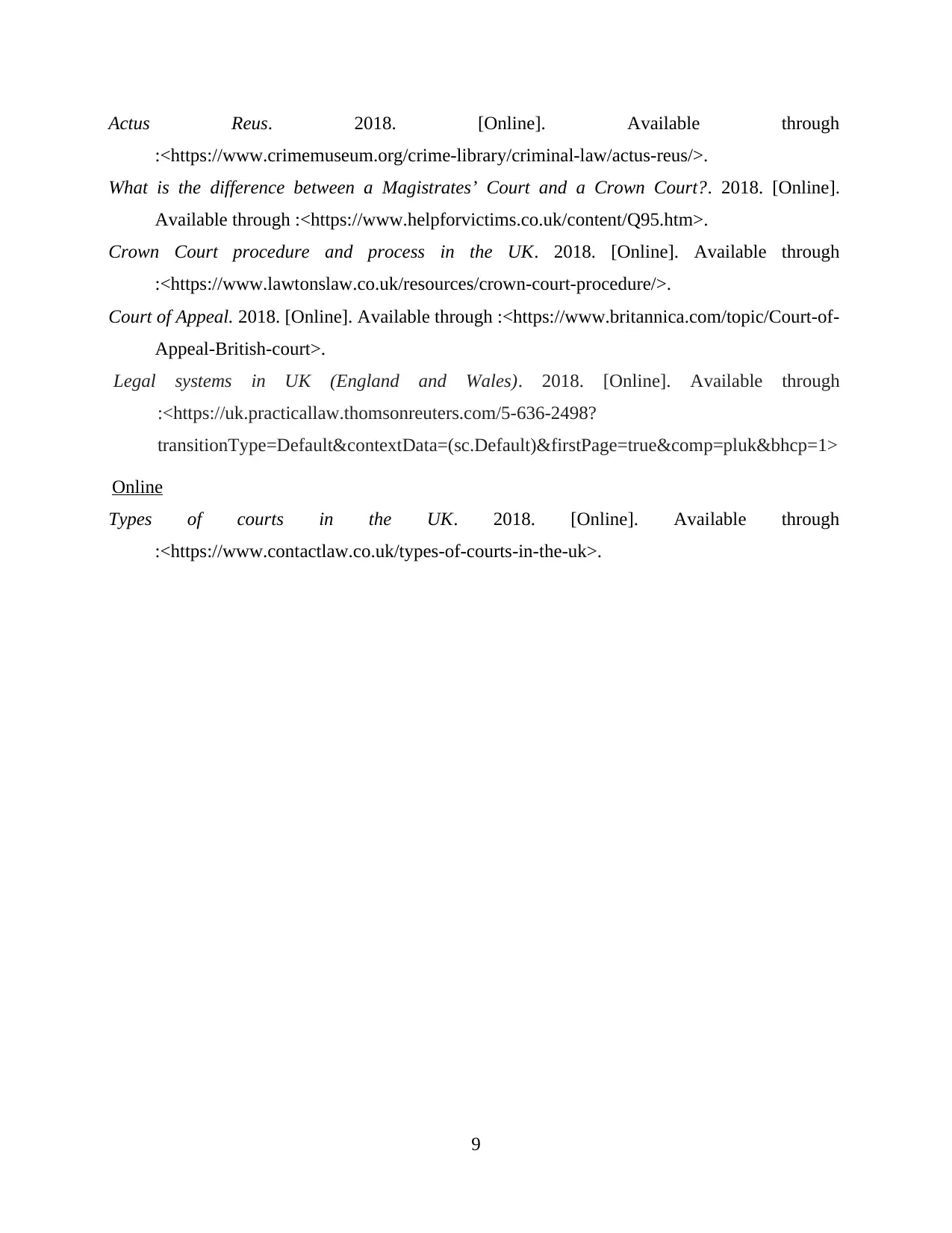
Actus Reus. 2018. [Online]. Available through
:<https://www.crimemuseum.org/crime-library/criminal-law/actus-reus/>.
What is the difference between a Magistrates’ Court and a Crown Court?. 2018. [Online].
Available through :<https://www.helpforvictims.co.uk/content/Q95.htm>.
Crown Court procedure and process in the UK. 2018. [Online]. Available through
:<https://www.lawtonslaw.co.uk/resources/crown-court-procedure/>.
Court of Appeal. 2018. [Online]. Available through :<https://www.britannica.com/topic/Court-of-
Appeal-British-court>.
Legal systems in UK (England and Wales). 2018. [Online]. Available through
:<https://uk.practicallaw.thomsonreuters.com/5-636-2498?
transitionType=Default&contextData=(sc.Default)&firstPage=true&comp=pluk&bhcp=1>
Online
Types of courts in the UK. 2018. [Online]. Available through
:<https://www.contactlaw.co.uk/types-of-courts-in-the-uk>.
9
:<https://www.crimemuseum.org/crime-library/criminal-law/actus-reus/>.
What is the difference between a Magistrates’ Court and a Crown Court?. 2018. [Online].
Available through :<https://www.helpforvictims.co.uk/content/Q95.htm>.
Crown Court procedure and process in the UK. 2018. [Online]. Available through
:<https://www.lawtonslaw.co.uk/resources/crown-court-procedure/>.
Court of Appeal. 2018. [Online]. Available through :<https://www.britannica.com/topic/Court-of-
Appeal-British-court>.
Legal systems in UK (England and Wales). 2018. [Online]. Available through
:<https://uk.practicallaw.thomsonreuters.com/5-636-2498?
transitionType=Default&contextData=(sc.Default)&firstPage=true&comp=pluk&bhcp=1>
Online
Types of courts in the UK. 2018. [Online]. Available through
:<https://www.contactlaw.co.uk/types-of-courts-in-the-uk>.
9
1 out of 11
Related Documents
Your All-in-One AI-Powered Toolkit for Academic Success.
+13062052269
info@desklib.com
Available 24*7 on WhatsApp / Email
![[object Object]](/_next/static/media/star-bottom.7253800d.svg)
Unlock your academic potential
© 2024 | Zucol Services PVT LTD | All rights reserved.




